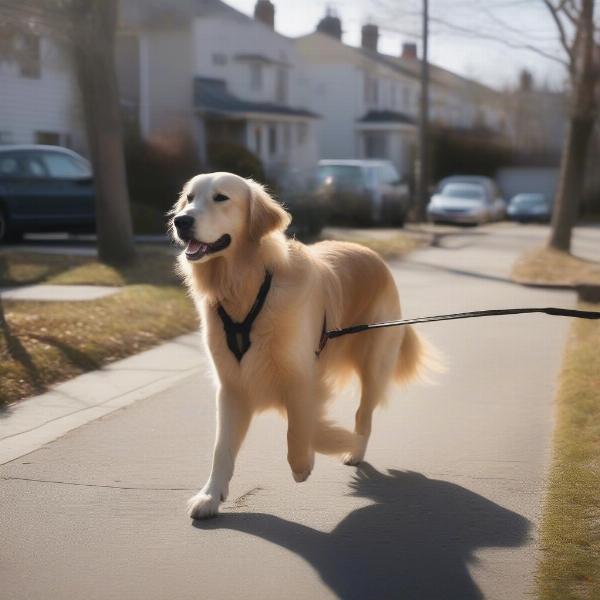Dog weights, used correctly, can be a valuable tool in building muscle and improving your dog’s overall fitness. Whether you’re aiming for peak performance in canine sports or simply want a stronger, healthier pet, understanding how to safely and effectively incorporate weights into your dog’s exercise routine is crucial. This guide will cover everything you need to know about using dog weights, from choosing the right type to designing a safe and effective workout plan.
Choosing the Right Dog Weights
The type of weight you choose for your dog will depend on their size, breed, and fitness level. Lightweight vests are a good starting point for most dogs, distributing weight evenly across the body. Ankle weights can be used for targeted muscle building in the legs, particularly beneficial for agility dogs. Remember, starting slowly and gradually increasing the weight is key to avoiding injury.
Designing a Safe and Effective Workout Plan
Before starting any weight training program for your dog, consult with your veterinarian. They can assess your dog’s overall health and advise on a suitable starting weight and exercise regimen. Just like humans, dogs need a balanced workout routine. Combine weight training with other exercises like walking, swimming, or fetch to ensure overall fitness.
Benefits of Using Dog Weights
Using dog weights correctly can lead to several benefits, including increased muscle mass, improved strength and endurance, and better joint stability. For working dogs or those participating in canine sports, weight training can enhance performance and reduce the risk of injury. Even for senior dogs, light weight training can help maintain muscle mass and mobility.
 Senior Dog Walking with Light Ankle Weights
Senior Dog Walking with Light Ankle Weights
Potential Risks and Precautions
While dog weights can be beneficial, it’s important to be aware of the potential risks. Using too much weight or improper form can lead to muscle strains, joint problems, and even fractures. Never leave a dog unattended while wearing weights, and always monitor them closely for signs of fatigue or discomfort.
Harness with Weights for Dogs: A Specialized Approach
A weighted harness is another option for building muscle in dogs. These harnesses allow for the even distribution of weight, and are often used in training for specific activities like weight pulling. It is crucial to ensure the harness fits correctly and the weight is appropriate for the dog’s size and strength.
What Weight Should I Use For My Dog?
The ideal weight for your dog depends on factors such as their breed, age, and current fitness level. Consult with your veterinarian for personalized recommendations. Starting with a very light weight and gradually increasing it as your dog builds strength is crucial. Overloading your dog with excessive weight can lead to injuries.
Can I Use Dog Weights for Weight Loss?
While weight training can contribute to a healthier weight, it shouldn’t be the sole focus for weight loss. A balanced diet and regular cardio exercise are essential for achieving healthy weight management in dogs. Dog weights can be a valuable addition to a comprehensive weight loss program, supporting muscle development and overall fitness.
How Often Should I Use Weights with My Dog?
The frequency of weight training sessions depends on your dog’s individual needs and fitness goals. For most dogs, 2-3 sessions per week are sufficient, with rest days in between for muscle recovery. Always observe your dog for signs of fatigue and adjust the frequency and duration of workouts accordingly.
Conclusion
Using dog weights can be an effective way to build muscle, improve fitness, and enhance performance in your canine companion. However, it’s crucial to prioritize safety and follow a well-structured plan. By choosing the right type of weight, starting slowly, and monitoring your dog closely, you can help them achieve their full physical potential while minimizing the risk of injury. Always consult with your veterinarian before starting any new exercise program.
FAQ
- Is weight training suitable for all dog breeds? While most breeds can benefit from weight training, certain breeds with predispositions to joint issues require extra caution. Consult your vet for breed-specific advice.
- What are the signs of overexertion in a dog during weight training? Excessive panting, lagging behind, limping, or whining can indicate overexertion. Stop the exercise immediately if you observe these signs.
- Can puppies use weights? Weight training is generally not recommended for puppies as their bones and joints are still developing. Focus on age-appropriate exercises like play and short walks.
- What are some alternatives to dog weights? Activities like hill climbing, swimming, and pulling a weighted cart can provide similar muscle-building benefits without the need for specialized weights.
- How do I choose the right size weighted vest for my dog? Measure your dog’s chest girth and consult the manufacturer’s sizing chart to ensure a proper fit.
- Can I use human ankle weights on my dog? No, human ankle weights are not designed for dogs and may not fit properly or distribute weight evenly, potentially leading to injury.
- What type of weight is best for building muscle in a dog’s legs? Ankle weights or weighted harnesses can be effective for targeting leg muscles, but should be used with care and under the guidance of a veterinarian or professional dog trainer.
We’d love to hear from you! Share your experiences with dog weights in the comments below. Have you seen positive results? What challenges have you faced?
ILM Dog is a leading online resource for dog owners worldwide, dedicated to providing expert advice on all aspects of dog care and wellbeing. From breed selection and health advice to training tips and product recommendations, we’re here to help you navigate the joys and challenges of dog ownership. Whether you’re a seasoned dog parent or just starting out, ILM Dog is your trusted companion on this incredible journey. For expert advice, contact us via email at [email protected] or call us at +44 20-3965-8624.